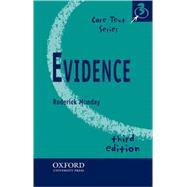
| Preface | xi | ||||
| Table of statutes | xiii | ||||
| Table of cases | xxi | ||||
| Introduction | 1 | (14) | |||
| Chapter one Relevance and admissibility of evidence | 15 | (52) | |||
|
17 | (3) | |||
|
20 | (4) | |||
|
24 | (1) | |||
|
25 | (7) | |||
|
32 | (11) | |||
|
43 | (15) | |||
|
58 | (7) | |||
|
65 | (1) | |||
|
65 | (2) | |||
| Chapter two Presumptions and the burden of proof | 67 | (50) | |||
|
68 | (2) | |||
|
70 | (2) | |||
|
72 | (2) | |||
|
74 | (6) | |||
|
80 | (2) | |||
|
82 | (2) | |||
|
84 | (1) | |||
|
85 | (1) | |||
|
86 | (1) | |||
|
87 | (28) | |||
|
115 | (1) | |||
|
115 | (2) | |||
| Chapter three Witnesses: competence, compellability and various privileges | 117 | (38) | |||
|
118 | (2) | |||
|
120 | (8) | |||
|
128 | (1) | |||
|
129 | (18) | |||
|
147 | (5) | |||
|
152 | (1) | |||
|
153 | (2) | |||
| Chapter four The course of the trial | 155 | (64) | |||
|
156 | (1) | |||
|
157 | (1) | |||
|
158 | (1) | |||
|
159 | (1) | |||
|
160 | (5) | |||
|
165 | (18) | |||
|
183 | (1) | |||
|
184 | (5) | |||
|
189 | (3) | |||
|
192 | (24) | |||
|
216 | (1) | |||
|
217 | (2) | |||
| Chapter five Witnesses' previous consistent statements and the remnants of the rule against narrative | 219 | (28) | |||
|
220 | (22) | |||
|
242 | (1) | |||
|
243 | (2) | |||
|
245 | (1) | |||
|
246 | (1) | |||
|
246 | (1) | |||
| Chapter six Character and credibility | 247 | (20) | |||
|
247 | (2) | |||
|
249 | (1) | |||
|
250 | (4) | |||
|
254 | (9) | |||
|
263 | (1) | |||
|
264 | (3) | |||
| Chapter seven Evidence of the defendant's bad character | 267 | (78) | |||
|
268 | (73) | |||
|
273 | (65) | |||
|
338 | (3) | |||
|
341 | (1) | |||
|
342 | (3) | |||
| Chapter eight The opinion rule and the presentation of expert evidence | 345 | (30) | |||
|
346 | (1) | |||
|
347 | (2) | |||
|
349 | (19) | |||
|
368 | (3) | |||
|
371 | (2) | |||
|
373 | (1) | |||
|
374 | (1) | |||
| Chapter nine The rule against hearsay | 375 | (74) | |||
|
376 | (70) | |||
|
379 | (62) | |||
|
441 | (5) | |||
|
446 | (1) | |||
|
446 | (3) | |||
| Chapter ten Confessions | 449 | (46) | |||
|
452 | (1) | |||
|
453 | (3) | |||
|
456 | (3) | |||
|
459 | (19) | |||
|
478 | (1) | |||
|
479 | (1) | |||
|
479 | (2) | |||
|
481 | (1) | |||
|
481 | (4) | |||
|
485 | (7) | |||
|
492 | (1) | |||
|
492 | (3) | |||
| Chapter eleven Drawing adverse inferences from a defendant's omissions, lies or false alibis | 495 | (54) | |||
|
496 | (6) | |||
|
502 | (40) | |||
|
542 | (4) | |||
|
546 | (1) | |||
|
547 | (1) | |||
|
548 | (1) | |||
| Chapter twelve Identification evidence | 549 | (30) | |||
|
550 | (1) | |||
|
550 | (10) | |||
|
560 | (8) | |||
|
568 | (1) | |||
|
569 | (1) | |||
|
570 | (1) | |||
|
571 | (1) | |||
|
572 | (4) | |||
|
576 | (1) | |||
|
577 | (1) | |||
|
578 | (1) | |||
| Chapter thirteen Documents | 579 | (10) | |||
|
580 | (1) | |||
|
580 | (1) | |||
|
581 | (1) | |||
|
582 | (1) | |||
|
583 | (2) | |||
|
585 | (2) | |||
|
587 | (2) | |||
| Index | 589 |
The New copy of this book will include any supplemental materials advertised. Please check the title of the book to determine if it should include any access cards, study guides, lab manuals, CDs, etc.
The Used, Rental and eBook copies of this book are not guaranteed to include any supplemental materials. Typically, only the book itself is included. This is true even if the title states it includes any access cards, study guides, lab manuals, CDs, etc.